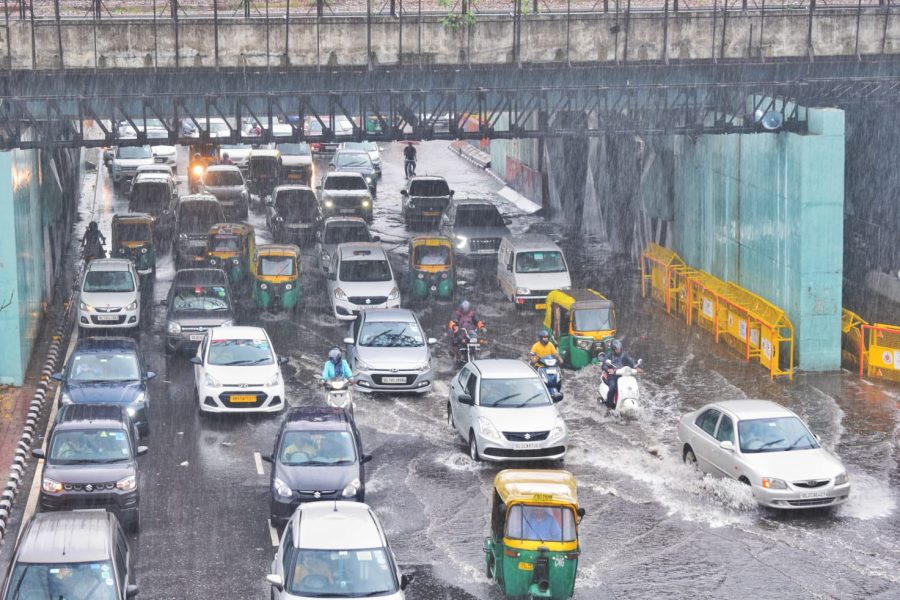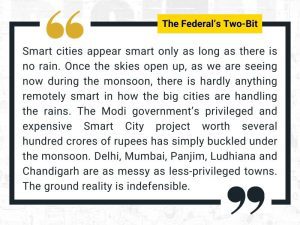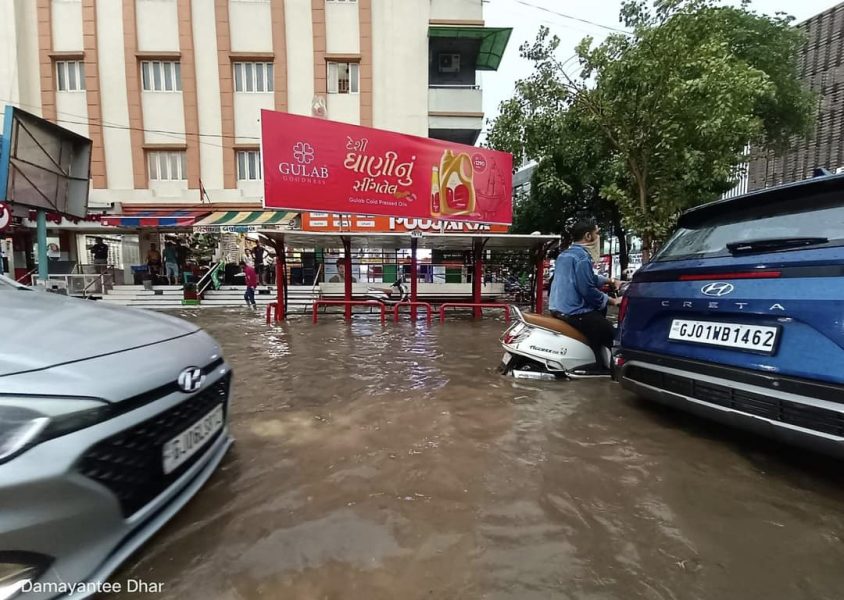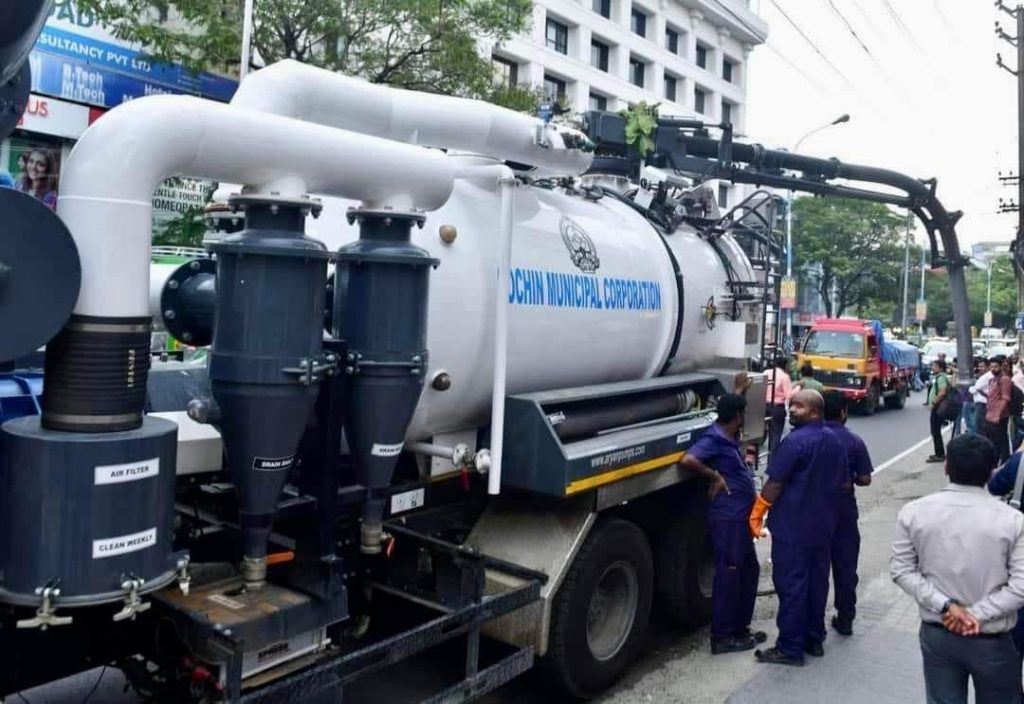
How the monsoon flushed away tall claims on Smart Cities project

Heavy rains in various parts of the country over the last few days have virtually exposed the government’s tall claims of promoting ‘smart cities’ that provide core infrastructure, sustainable environment and a decent quality of life to citizens.
A downpour in major cities like New Delhi and Chandigarh brought to the fore the perennial problem of waterlogging, which once again threw normal life out of gear and caused great inconvenience to commuters who were left to deal with traffic snarls on inundated roads. It also underlined the fact that the rapid pace of urban development and changing climate are putting the existing urban drainage systems (UDS) under greater stress.
The Union government had launched Smart Cities Mission in 2015 with an aim to drive economic growth and improve quality of life, but eight years down the line it seems the ground reality hasn’t changed much as far as preparedness of urban authorities to deal with the rainy season is concerned. The Federal carried out a reality check in various states to bring you the prevailing scenario in the aftermath of record rainfall in different parts of the country.
Delhi: Archaic drainage system
Delhi witnessed unprecedented rainfall exceeding 150 mm within a span of three days (July 8-July 10). This is the highest rainfall recorded in such a short duration in the last 40 years.
Also read | Rat fever in monsoon: What it is, how it is caused, and how you can prevent it
Speaking to The Federal, Dr Amitabh Kundu, senior fellow with sustainable cities and transport programme at WRI, said: “Though the population in Delhi has increased about four times as compared to 1970s, the current drainage master plan still follows the one drawn up in 1976 when the population was just around 60 lakh.” The gravity of the situation may be gauged from the fact that even Chief Minister Arvind Kejriwal admitted during a press conference that the city’s drainage system is not designed to handle excessive rainfall.
The Delhi government had appointed PWD as the nodal agency for the implementation of Delhi’s drainage master plan in 2021. As often seen in the national capital, the issue of waterlogging and inconvenience caused due to excessive rainfall has led to a war of words between the elected government and the Lieutenant-Governor VK Saxena. While the L-G has accused the Delhi government of not having a contingency plan in place despite a clear warning from the IMD, the AAP has accused the L-G of “making false promises” of cleaning Yamuna and desilting drains.
The state budget of 2023-24 had mentioned that sewage treatment capacity will be increased from 373 MGD (million gallons a day) in 2015 to 890 MGD in 2024. A senior official from the civil body said 90 per cent of the drains that come under the jurisdiction of the corporation have been desilted and the remaining work will also be completed soon. The civic body had allocated Rs 13.7 crore for desilting drains in the national capital.
A total of 106 projects have been envisaged under the Smart City Mission in Delhi. Out of these, 86 have been completed while six are at the DPR stage, according to the Economic Survey of Delhi 2021-22.
Explainer: Monsoon in India, interesting facts and its impact
Residents of Delhi have expressed dissatisfaction over the condition of civic facilities and have questioned AAP government’s plan of taking the help of German experts in making roads world-class. Most of them believe that proper planning for weather contingencies along with implementation of schemes earmarked for civic upkeep can truly address problems like waterlogging as extreme weather events have become more common. However, they lauded the efforts of ministers and state officials in leading the mitigation efforts in the aftermath of the recent spell of downpour.
Bengaluru: No respite from waterlogging woes
The drainage system of the country’s tech capital is in dire straits, thanks to Bruhat Bengaluru Mahanagara Palike (BBMP), whose storm water department appears indifferent towards the city’s waterlogging woes.
The drainage system, in which main drains (Rajakaluve) connect the lakes in the city, is decades-old and had virtually collapsed in the late 1990s when the real estate boom hit Bengaluru. Encroachment of lakes, lake beds and drainages led to disappearance of several drains, adding to the city’s flooding problems.
The cadastral maps of the 1900s show the total length of primary and secondary drains in Koramangala and Vrishabhavathi valleys to be around 113 km and 226 km, respectively. However, they have lost more than 50 per cent of their drain length over the years, bringing down their carrying capacity.

According to an Indian Institute of Science (IISc) study, the plague outbreak in 1889 forced the town administration authorities to provide wider roads, open drains and sewage carrier lines. Localities such as Basavanagudi and Malleswaram were provided with conservancy roads and a good network of drains. The system for the disposal of domestic and industrial waste was established in Bangalore in the early 1930s, which was initially confined to the densely populated old parts of the city.
Following completion of the Thippagondanahalli reservoir in 1940s, the extension work gained momentum. The old city and 60% of the former civil and military area had got sewerage network by 1960s, and about 60,000 connections had been provided to the sewers. It was followed by major sewerage development work under the first three phases of the Cauvery project (CWSS), extending from the mid-1970s to late 1990s.
This year, the government announced a Rs 3,000-crore project to tackle flooding in Bengaluru. Funded by the World Bank through a long-term loan, the massive outlay to mitigate climate change was part of the Rs 9,698-crore project announced in the state budget for the city’s “comprehensive development”. BBMP’s work order data says that 74% of funds were meant for roads and drain works in the last five years. As per the data, Rs 3,345 crore were allocated for drainage work in the past five years.
Though the government may be spending crores of rupees to address the problem, the state of the drainage system in Bengaluru is worsening by the day and there is no scientific mechanism to resolve the issue.

Gujarat: Projects galore, but no change on ground
The tale of Gujarat is no different, where crores are being spent on the drainage systems of various cities, but it has failed to yield the desired results.
Six cities of Gujarat – Gandhinagar (state capital), Ahmedabad, Vadodara, Surat, Rajkot, and Dahod – are among the 100 cities picked under the Centre’s Smart Cities Mission (SCM).
In total, 281 projects evaluated to Rs 8,963 crore have been completed in Gujarat under the SCM while another 63 projects worth Rs 3,510 crore are at various stages of implementation.
Among the six cities, the maximum number of incomplete projects are in Gandhinagar and Rajkot. Surat has witnessed completion of 92 per cent of its projects. Similarly, the completion rate in Vadodara is 82 per cent, Ahmedabad 74 per cent and Dahod 67 per cent.
However, waterlogging is a perennial issue in the cities across Gujarat, especially Ahmedabad and Surat. Ahmedabad faces severe waterlogging issues whenever there is a heavy spell of shower. This year was no different, as the first heavy rain in Ahmedabad washed away roads, many of them recently repaired by the Ahmedabad Urban Development Authority (AUDA) and the Ahmedabad Municipal Corporation (AMC) in their respective jurisdictions. The road damage is so severe at some places that it has caused large craters laying bare the drainage lines underneath. Several underpasses of the city are submerged.
Basements of various housing societies in Ahmedabad also got flooded and vehicles submerged, leading to massive losses. The civic body fell short of machines to pump out water and the housing societies had to buy pumps.
In Rajkot district, roads were completely inundated. Even footpath and dividers were submerged in water, making it nearly impossible for people to step out to access basic necessities. NH-47, the national highway connecting Ahmedabad and Rajkot, is also waterlogged.

Kerala: Kochi emerges as silver lining
Kochi experienced prolonged rainfall last week, but much to the relief of the residents, there was no waterlogging this time. Major parts of the city were spared from flooding despite heavy rains that lasted for four to five days. Even MG Road, one of the city’s first to be flooded, didn’t get blocked.
It was a great respite and even the Kerala High Court commended the Kochi Municipal Corporation and the district administration for the effort. It appears that harsh public condemnation and constant rebukes from the court had a favourable impact. The prompt cleaning of drains with contemporary equipment and frequent follow-ups was one of the main reasons behind it.
“It is the hard work of the corporation and the state government that paid off,” MB Rajesh, the minister for local governance, told The Federal. “We could carry out the pre-monsoon cleaning activities at a cost of Rs 12 crore well in advance this year. The drainage cleaning only cost Rs 2.2 crore. We had built a new 5.5 km long drainage system and eight cross culverts this year which proved crucial. Dredging of city canals was another big factor. Usage of suction cum jetting pump was the highlight of this year’s pre-monsoon preparations that effectively prevented the city from waterlogging.” This machine can suck out mud and wastage from the drainage without opening the slabs, added the minister.
The government has sanctioned Rs 36 crore for the fourth phase of the Operation Breakthrough project, which was launched in 2019 with the intention of revitalising Kochi’s canal network. The project’s benefits were not apparent in its first three phases and the very project was drawing criticism from the general public and the courts as well. The poor result of the project was attributed to the lack of coordination between the district administration, Corporation of Kochi and the Greater Cochin Development Authority.
This time with the state government taking the lead with two ministers – LSG minister MB Rajesh and Industries Minister P Rajeev, and the corporation springing into action, there has been a respite from the decade-long problem of waterlogging.
Apart from Kochi, Thiruvananthapuram is the other city from Keral that features in the list of Smart Cities Mission. However, unlike the previous years, Thiruvananthapuram has received lesser rainfall this time, and therefore there hasn’t been any significant waterlogging in the capital city.
(With inputs from Rajeev Ramachandran in Kerala, Naveen Ammembala in Karnataka, Damyantee Dhar in Gujarat and Siddharth Chakraborty in New Delhi)


